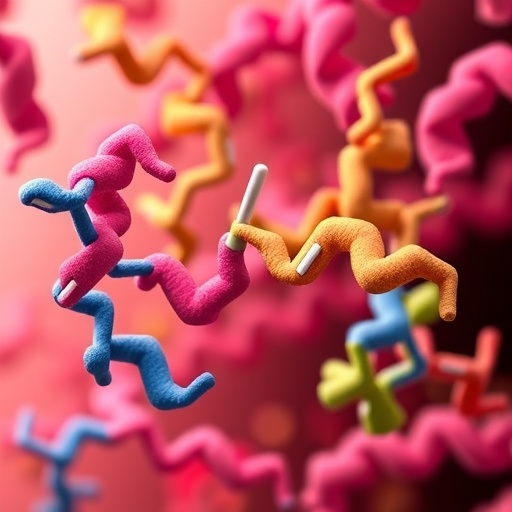In a groundbreaking study published in Molecular Diversity, researchers have unveiled a novel transfer learning framework designed to predict the activity of PTP1B inhibitors. This research is pivotal in drug discovery, particularly for diabetes and obesity, where PTP1B plays a significant role as a therapeutic target. The intricate relationship between natural and non-natural products and their inhibitory mechanisms is examined through innovative modeling techniques, providing insights that could revolutionize screening processes in pharmaceutical research.
The framework developed by Wang, Sun, and Ren et al. integrates advanced machine learning algorithms and a user-friendly web platform, making it accessible for researchers worldwide. Transfer learning, which involves adapting knowledge gained from one domain to enhance learning in another, has emerged as a powerful approach in predictive modeling, especially when dealing with limited datasets. By harnessing the power of transfer learning, the researchers aim to bridge the gap between diverse chemical space representations of natural and synthetic compounds.
This research highlights the challenges faced in predicting the efficacy of PTP1B inhibitors, particularly given the structural complexity and variability of compounds sourced from nature versus those created synthetically. Traditional modeling approaches often fall short due to the limited availability of annotated datasets specific to PTP1B inhibition. However, this new framework leverages data from multiple related tasks, augmenting the predictive power through shared knowledge, which is a significant advancement over conventional methods.
The researchers performed a rigorous evaluation of their model utilizing a comprehensive dataset comprising both natural and non-natural compounds known to exhibit PTP1B inhibitory activity. By employing a variety of neural network architectures, they fine-tuned their approach to harness the unique features of each compound type. This meticulous process underscored the need for tailored modeling strategies that consider the inherent differences in binding interactions attributed to natural versus synthetic origins.
Furthermore, the practical implementation of this framework sees the development of an online platform where researchers can input compound structures and receive predictions regarding their potential as PTP1B inhibitors. This democratization of data access represents a significant stride in making advanced computational tools available to the wider scientific community, fostering collaborations and speeding up drug discovery processes.
The transfer learning framework also addresses the critical issue of overfitting, a common challenge in machine learning, particularly with smaller datasets typical in pharmacology. By leveraging larger datasets from distinct but related tasks, the researchers successfully minimized overfitting risks, thereby enhancing the robustness of their predictive model. The implications of such advancements are paramount not just for PTP1B inhibitor research but for the broader field of medicinal chemistry.
Continuing on their journey, the researchers emphasize the importance of ongoing refinement of their model. Collecting more data, conducting further validation studies, and refining their web platform are all integral steps in ensuring that their predictions remain reliable and relevant in the rapidly evolving field of drug discovery. They also plan to expand the model’s applicability to other therapeutic targets, potentially setting a new standard in predictive analytics within pharmacology.
Importantly, this research does not end with PTP1B inhibitors; it opens up avenues for exploring similar computational approaches in various domains of drug discovery where complex interactions are commonplace. As researchers strive to understand how various compounds interact with biological systems, the integration of machine learning and data science will play an increasingly vital role.
In summarizing their work, Wang and his team acknowledge the collaborative nature of this research effort, highlighting the importance of interdisciplinary approaches in addressing complex scientific problems. They hope their framework inspires further innovation in predictive modeling, ultimately leading to more effective therapeutic interventions targeting metabolic diseases and beyond.
The potential applications of this research extend well beyond academia into the biotechnology and pharmaceutical industries, where rapid and accurate prediction of compound activity can significantly streamline pipelines. By effectively reducing the time and resources required for in vitro and in vivo testing, this framework may ultimately lead to more effective drugs reaching the market faster, improving patient outcomes in diabetes management and related conditions.
In conclusion, the innovative work conducted by Wang, Sun, and Ren et al. represents a significant step forward in the field of medicinal chemistry. By merging the realms of transfer learning and inhibitor activity prediction, they have crafted a robust tool that serves both the research community and the pharmaceutical industry. As their framework continues to evolve, the potential benefits of this research will surely extend far and wide, influencing future studies across various therapeutic landscapes. The interplay of natural and synthetic compounds within this modeling framework is poised to redefine how researchers approach drug discovery, paving the way for more targeted and personalized treatment strategies.
As this research is disseminated within the scientific community and beyond, one can anticipate an exciting new chapter in the pursuit of better therapeutic agents through innovative computational techniques and collaborative efforts.
Subject of Research: PTP1B inhibitor activity prediction using transfer learning framework.
Article Title: A transfer learning framework for PTP1B inhibitor activity prediction: differential modeling of natural and non-natural products with web platform implementation.
Article References: Wang, Z., Sun, L., Ren, A. et al. A transfer learning framework for PTP1B inhibitor activity prediction: differential modeling of natural and non-natural products with web platform implementation. Mol Divers (2025). https://doi.org/10.1007/s11030-025-11400-6
Image Credits: AI Generated
DOI: https://doi.org/10.1007/s11030-025-11400-6
Keywords: transfer learning, PTP1B inhibitors, drug discovery, machine learning, natural products, synthetic compounds, predictive modeling, pharmacology.




